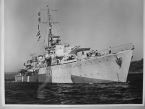obvert
Posts: 14050
Joined: 1/17/2011
From: PDX (and now) London, UK
Status: offline

|
quote:
ORIGINAL: Kull
quote:
ORIGINAL: Uncivil Engineer
I saw the article at the link a few days ago - an analysis of the passengers on the Diamond Princess that was quarantined in Japan (?) back in January (?). I don't know anything about the author or his qualifications (probably not medical), but this raises a lot of questions about the response to COVID-19.
https://wattsupwiththat.com/2020/03/16/diamond-princess-mysteries/
Some highlights - "some 83% (82.7% – 83.9%) of the passengers never got the disease at all"
"slightly less than half the passengers (48.6% ± 2.0%) who got the disease showed NO symptoms"
"There were a total of 7 deaths among those on board. All of them were in people over seventy"
7/~3635 = .0019257 or 1.9% death rate (3635 is my estimate from the first graph of the total number of pax. IIRC ALL of them were tested before they were allowed to leave the ship.
A question - the 83% who didn't get the disease; are they still carriers? Or did they test negative? The article doesn't say. I would assume that those who showed no symptoms WERE infected AND were carriers, and could infect others when they got home.
Back on March 2nd (feels like years ago) I posted an analysis of this, and I still think it's relevant:
quote:
ORIGINAL: Kull
I am not a medical professional, but to me the Diamond Princess is the closest thing we have to a coronavirus infection laboratory. Or at least a contained environment, where you might be able to look at the numbers and draw some conclusions. As far as we can tell, the virus began with a single passenger who boarded on 1/20 in Japan and departed in Hong Kong on 1/25. He was diagnosed in Hong Kong 6 days later, which is when the cruise line was notified and the saga began.
There's an article (mostly anecdote and innuendo) on what happened aboard during this period. Although readers are advised to have a large grain of salt close to hand, it does suggest that there was a fair amount of chaos involving the process of testing and treatment, and the entire environment was hardly "hospital sterile". Which, for our purposes, is actually kind of ideal since in that sense it's pretty close to what we're going to see as and when this thing rises up elsewhere.
Some numbers:
- 2/1: There were 3700 passengers and crew when the cruise was routed back to Yokohama
- 2/4: The ship arrived and was placed in quarantine.
- 2/6: Announced that 41 passengers/crew tested positive (41)
- 2/9: 66 more positives (107)
- 2/11: 39 positives (146)
- 2/16: 67 positives (213). "High risk" individuals identified, 67 of which tested negative, 12 of these to be disembarked.
- 2/18: 169 positives (382)
- 2/19: Quarantine period ends. 600 "guests" who tested negative allowed to depart (will undergo additional 14 day quarantine in their home countries)
At that point I can't find additional sources to give us the daily counts, but as of today, this website says the numbers are:
- 3/1: 705 cases, 7 deaths, 100 recovered, 36 "serious/critical"
So let's do some math:
- If we assume the contagion started on 1/20, it took 43 days to infect 705 of 3700 (19%)
- 7 of 705 have died, so the mortality rate (among those exposed) is 1%
- At least some of the 36 "serious/critical" cases could still succumb, so the worst case fatality rate would be 6% (although that's clearly unlikely)
The takeaways:
- "Local" fatality rates could get pretty high when/if this thing gets into vulnerable populations. Nursing homes or old age communities could be scary places.
- It's hard to imagine any environment "more communal" than a cruise ship, yet with unrecognized and uncontained spread underway for 16 days, we still have a pretty low contagion rate which appears to have maxed out at 19%.
- That's not nothing, but it certainly implies that if people take reasonable precautions, they should be pretty safe. And for those who are not in the "high risk" categories, it's more likely to hit you as an extremely nasty case of the flu. Unpleasant yes, but not the end of the world.
I agree. I also just saw something (will try to find link) that said a "contact" with someone who has it would have a 1-5% chance of passing the virus. The range was caused by duration of contact.
_____________________________
"Success is the ability to go from one failure to another with no loss of enthusiasm." - Winston Churchill
|
 Printable Version
Printable Version






















 from influenza to the number of infected and dead
from influenza to the number of infected and dead 





 New Messages
New Messages No New Messages
No New Messages Hot Topic w/ New Messages
Hot Topic w/ New Messages Hot Topic w/o New Messages
Hot Topic w/o New Messages Locked w/ New Messages
Locked w/ New Messages Locked w/o New Messages
Locked w/o New Messages Post New Thread
Post New Thread